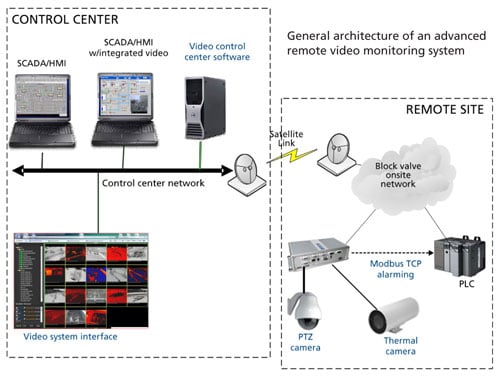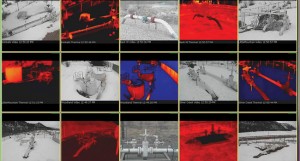This post was written by Greg Santos, an engineer with nearly 20 years experience in the process automation industry.
There has been much advancement in recent years in hardware and software technologies that are enabling more choices in instrumentation that can be put into the field and data that can be brought back to the control room. However, this equipment only provides you with data. This data must be interpreted into practical information in order to be an effective monitoring, control, and automation tool. There remains a gap between the data that is being delivered and deduction of what this data is actually telling you about your process. A comprehensive remote video monitoring system can bridge this gap.
Such a system could deliver critical data that has already been interpreted into meaningful information about your process. Although the video by itself is useful, video that is correlated and tied into your supervisory control and data acquisition (SCADA) system would be even more meaningful. In the ideal remote video monitoring system, a camera is a sensor, delivering vital visual data about your process. The local DVR is the programmable logic controller (PLC) or remote terminal unit (RTU), continually processing and storing video data from the camera. With the proper video management software, this video data can be seamlessly integrated into your SCADA system to give you more information about your process and allow you to make efficient and cost-effective decisions more quickly.
A typical video and alarming solution would consist of:
- Industrial and hazardous area cameras
- Networking components, such as power over Ethernet and wireless devices
- Video historians—video recording and processing appliances
- SCADA integration software—OPC and Modbus TCP servers, as well as SCADA video windows
- A web-based and mobile viewing application for viewing video and alarming
Bridging the gap
Video is becoming a standard type of data that SCADA systems are utilizing for more information and a clearer picture about what is happening in the field. Pushing the envelope even further, more advanced video management systems seamlessly integrate into your control system with the following capabilities:
- Communicate directly to your PLC/RTU in the field. A video historian device is connected directly to the cameras in the field, continuously storing and processing video data. An integrated Modbus TCP Server on the video historian creates a bi-directional interface with remote PLC/RTU devices. The Modbus TCP Server can send camera-initiated alarms directly to the PLC/RTU, allowing for integration of video alarming directly into the control system. This truly allows the camera to act as a sensor. The important part is that the integration is done at the edge, where the sensors and control of your remote site should be done. Furthermore, the video historian's Modbus TCP Server can accept incoming signals from the remote PLC/RTU and perform actions such as:
- Starting/stopping video recording
- Arming/disarming of the system
- Moving a camera to a specific location
- Creating video clip recordings surrounding an event
This allows for complete control of your remote video systems and cameras by the SCADA system.
- Utilize your existing network to transmit video. Remote sites typically make use of dedicated radio networks to transmit process data back to the control room. Network bandwidth can vary from 9600 baud serial radios to higher bandwidth TCP/IP radios. An advanced video management system should be able to transmit video over any network, as well as encapsulate the video into the PLC protocol you are using. For example, this system should be able to transmit video over an existing serial Modbus network by encapsulating the video in the Modbus protocol. In this case, the video historian device looks just like another PLC or RTU on your network.
- Integrate video directly into your SCADA/HMI screens. The video management system user interface should provide video viewing directly into your operator screens. This should be feasible even on systems that do not support ActiveX control technologies.
- Integrate video alarms into your existing alarm summary. The video management system should contain an OPC Server that creates a bi-directional interface with the SCADA system and allow you to insert video system alarms into your SCADA system, as well as control the video system from the SCADA side. This interface should also let you move cameras, turn recording on and off, and create video snippets all through OPC commands from the SCADA side.
- Overlay process data directly on the video image. An advanced remote video management system should allow you to "burn" data values directly on the video stream you are viewing. This will allow users to place the important, most used data directly on the video image to give operators more information in a single view.
- Correlating SCADA system events with video. An advanced remote video management system should allow you to simply click on an alarm or event in your system and automatically bring up the video that occurred at that time, correlating the video with historical SCADA data.

Safeguarding against network or equipment outages
An advanced video monitoring system should continuously record video at the edge. At the edge means "where the cameras are." All the real-time, high-resolution video storage and processing can be done in a distributed fashion, which mirrors a PLC or RTU type of network. This system architecture does not rely on a continuous network connection for the recording of video. The network is only used when an operator wants to see live video or the system detects an alarm condition and creates a video event clip.
Efficient use of your network
In the architecture we are describing, high-resolution video is stored at the edge. However, lower resolution, lower frame rate video should be able to be transported over your given network. This allows you to tailor the video to fit your scenario, all the while recording the highest resolution video and keeping it in a safe place locally. Along with bandwidth management, an advanced video management system should use your existing control network without interfering with important process data. Mechanisms in such a system should prevent video data from obstructing control system messages. This effectively would act as a type of control system quality of service (QoS), making sure the most important data transmissions are prioritized first.
Control room integration
In the central control room, the video control center component of the advance video management software is installed. The video control center would act as a portal for viewing and sharing video and alarming with other systems. It should utilize OPC and Modbus TCP technologies to share video alarms and insert alarms directly into the alarm system of the SCADA/HMI. Video windows should be able to be inserted along with alarms into the operator interface screens, allowing them to review video on the same system they are using for control and automation.
An advance video management system should also give you the ability to view your remote assets live or go back in time to any point to see what occurred. This allows you to troubleshoot issues efficiently and effectively and reduces frequent site visits and the manpower needed. By using the camera as a sensor, the video system delivers ready-to-use information, providing quick reaction to alarms and events.
What follows are examples of how such an advanced video management system was implemented to solve specific remote monitoring problems
Case Study 1: Securing and monitoring a crude oil pipeline
In January of 2011, the Pipeline and Hazardous Materials Safety Administration (PHMSA) invoked a requirement for Chevron to secure and monitor their remote block valve sites for pipeline leaks. PHMSA is a U.S. Department of Transportation agency that develops and enforces regulations for the safe, reliable, and environmentally sound operation of the nation's 2.6-million mile pipeline transportation system and the nearly one million daily shipments of hazardous materials by land, sea, and air. Pipeline leaks can have a devastating cost in terms of lost production and cleanup effort, not to mention the environmental impact.
Chevron began investigating the options for security, monitoring, and leak detection. Their initial investigation included technologies ranging from 24-hour manned surveillance to radioactive isotope tracers for leak detection. After the evaluation, they decided on a remote video monitoring solution that included advanced video management software and a new hazardous area thermal sensor.
Chevron utilized an advanced video management solution that included the following system components:
- Control Room: Video control center software for integration of video into operator SCADA/HMI screens.
- Remote Site: Remote DVR appliance for on-site recording, alarming, and direct communication to the PLC.
- Cameras:
- Thermal imaging camera for pipeline leak detection
- Pan-tilt-zoom camera for overall site surveillance
A new type of sensor
The solution provided integrates a thermal imaging used to detect hydrocarbon leaks and spills. The camera is optimized for persistent, 24-hour leak detection in locations where pipes rise above ground. The camera is used to detect thermal anomalies present when fluid or high-pressure gaseous leaks occur. The system provides spill detection over the full range of temperature conditions.
Smarter and faster alarm verification
When the thermal camera senses a leak detection event, it immediately alerts the PLC at the remote site via Modbus TCP. The PLC will then send a prioritized alarm message back to the control center. The Longwatch video engine simultaneously records a ten-second video clip surrounding the leak event. This snippet of video is sent over the control network back to the operator's console. The operator now has the ability to have more information about the event in the form of video. This allows smarter and faster decision-making and gives the operator the information needed to respond to the event appropriately.
Case Study 2: More process control system information at your fingertips
Consol Energy, a publicly owned Pittsburgh-based producer of coal and natural gas, is one of the leading diversified energy companies in the U.S. Due to their various operations, they have a vastly distributed control system network. Multiple remote SCADA/HMI branches all connect back to a main control center in Claypool Hills, Virginia. They were experiencing a problem with blind spots (i.e., areas of their process they did not have vision into). This included the operator's HMI screens at any number of their remote stations. Frequent SCADA/HMI-related problems caused a great deal of time to be put into supporting these remote operations over the phone or making frequent site visits to these extremely remote locations. The time and manpower required to support this kind of remote application was significant.
One such site was a gas processing facility in West Virginia, the next state over. The entire remote processing system was operated by a skeleton crew. The data from the remote location was sent back to the main control center in Virginia, but it did not provide enough information to properly troubleshoot and find the root cause of issues.
Visual confirmation of operator activity
Consol Energy decided to implement a video management system that included the capability to record operator consoles. The console recorder is a software module that enables automatic recording of the HMI or SCADA operator's console display. With this tool, Longwatch archives exactly what the operator was seeing, because it records the video that is being sent to the display itself. Playing back what the operator was seeing proved to be a very valuable method for troubleshooting, training, and process improvement.
The recorder software provides access to live and recorded video of the operator's screens. In this way, the control room in Virginia can have access to exactly what the remote operator's screens look like at any given point in time. Managers can view their operator's screens live or go back in time to any point to see what the screen looked like in the past.
The operator's console should be looked upon as an asset, just like an important piece of equipment or part of your process. Consol Energy is now able to troubleshoot issues in real time or find out why an operator did not acknowledge an alarm. Was it due to operator error or did the HMI screen malfunction?
Remote emergency management
After the success of the console recording approach, Consol Energy wanted to add visual monitoring of their remote assets. At the same plant where the operator's consoles were being recorded, Class I Division 2 cameras were put in place to monitor critical, potentially hazardous areas of their manufacturing process. When emergency situations arise, there is a need to determine the whereabouts of site personnel and also establish which part of the plant is affected. The Class I Division 2 pan-tilt-zoom cameras provide remote "eyes" necessary to accurately assess the situation.
Consol Energy now has complete vision into their remote applications. The advanced video management system deployed provides video from operator screens along with video from hazardous area cameras that can be viewed anywhere on their network.
In summary
Software and hardware technologies are now available to create a comprehensive remote video monitoring solution. Advanced video management software technologies now provide:
- Integration of live video into operator SCADA and HMI screens
- Correlation of saved video clips of process operation with historical and event-based SCADA data
- High-resolution/high-frame rate recording at the site, even when the remote communication is lost
- Recording of operator consoles for correlation with other saved process video for incident investigation or operator training
- Transmission of live video streams back to central control room over low-bandwidth or bandwidth-constrained connections, including over field protocols, such as Modbus
The software described above allows you to view a camera as just another sensor, delivering far more information than a few points of data. The facility, combined with the advanced industrial camera technologies now available, provides for powerful remote monitoring solutions that enhance personnel safety, site security, and process productivity.
About the Author Greg Santos is an engineer with nearly 20 years experience in the process automation industry. He has worked for Industrial Video and Control, where his responsibilities included project management and technical training of integrators and end users. He has held technical support and field applications roles for SCADA and HMI systems, application engineering for SCADA and HMI solutions in multiple industries.
Greg Santos is an engineer with nearly 20 years experience in the process automation industry. He has worked for Industrial Video and Control, where his responsibilities included project management and technical training of integrators and end users. He has held technical support and field applications roles for SCADA and HMI systems, application engineering for SCADA and HMI solutions in multiple industries.
A version of this article also was published at InTech magazine.




